Comprehensive Analysis of Research Methodologies in Business Studies
VerifiedAdded on 2020/04/13
|17
|3818
|48
Report
AI Summary
This report provides a comprehensive analysis of research methodologies employed in five different articles related to business studies. The report begins with an abstract and proceeds to dissect each article based on key research components. These include research objectives and questions, a critical evaluation of the literature review, the main business theories applied, the research type utilized, sampling designs, and the research instruments employed. The analysis covers a range of topics such as accruals management, marketing mix elements and brand equity, the impact of sponsorship on brand equity, customer brand preference segmentation, and relationship management in public relations. Each article is assessed individually, providing insights into the methodologies, approaches, and theoretical frameworks adopted by the respective authors. The report highlights the strengths and weaknesses of each methodology, offering a critical perspective on the research processes.
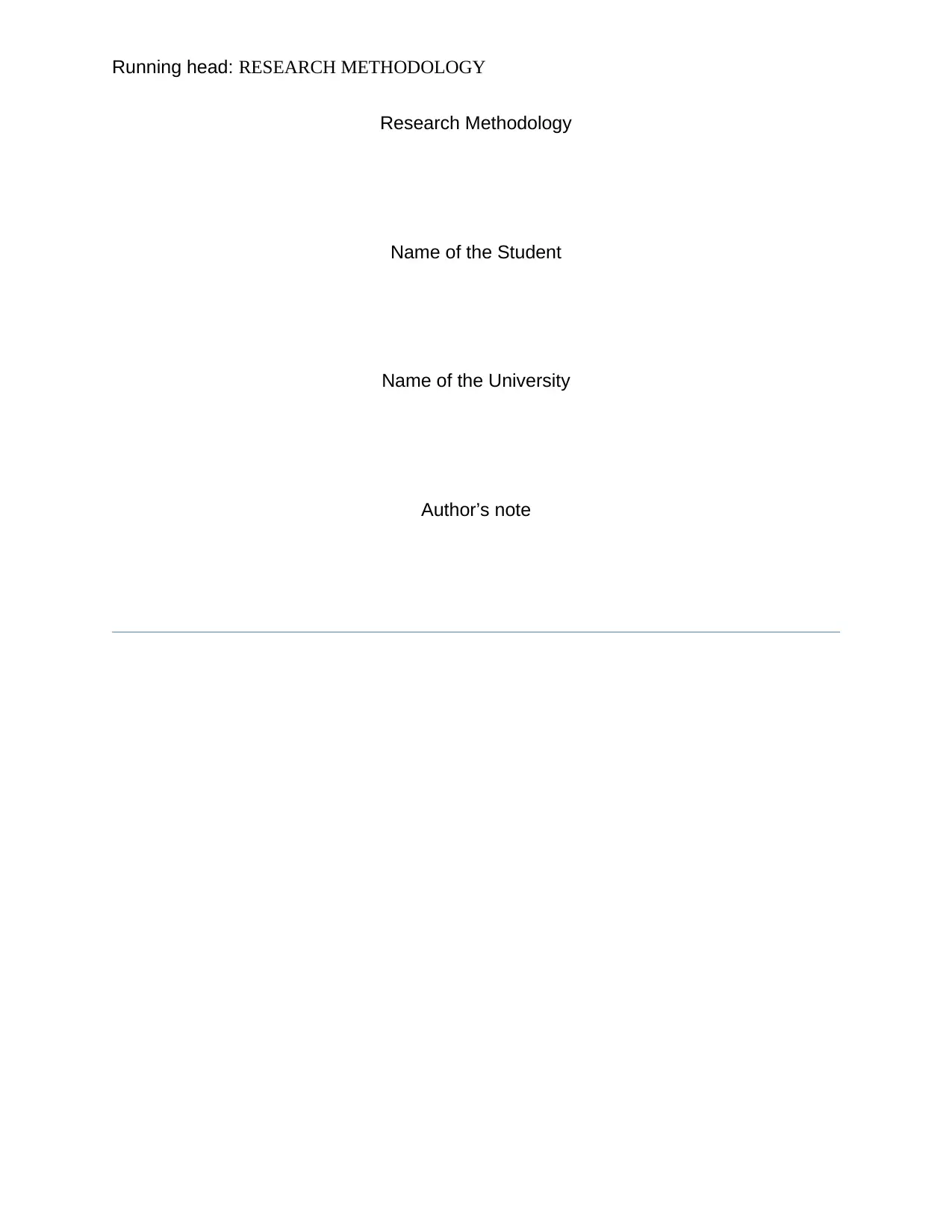
Running head: RESEARCH METHODOLOGY
Research Methodology
Name of the Student
Name of the University
Author’s note
Research Methodology
Name of the Student
Name of the University
Author’s note
Paraphrase This Document
Need a fresh take? Get an instant paraphrase of this document with our AI Paraphraser
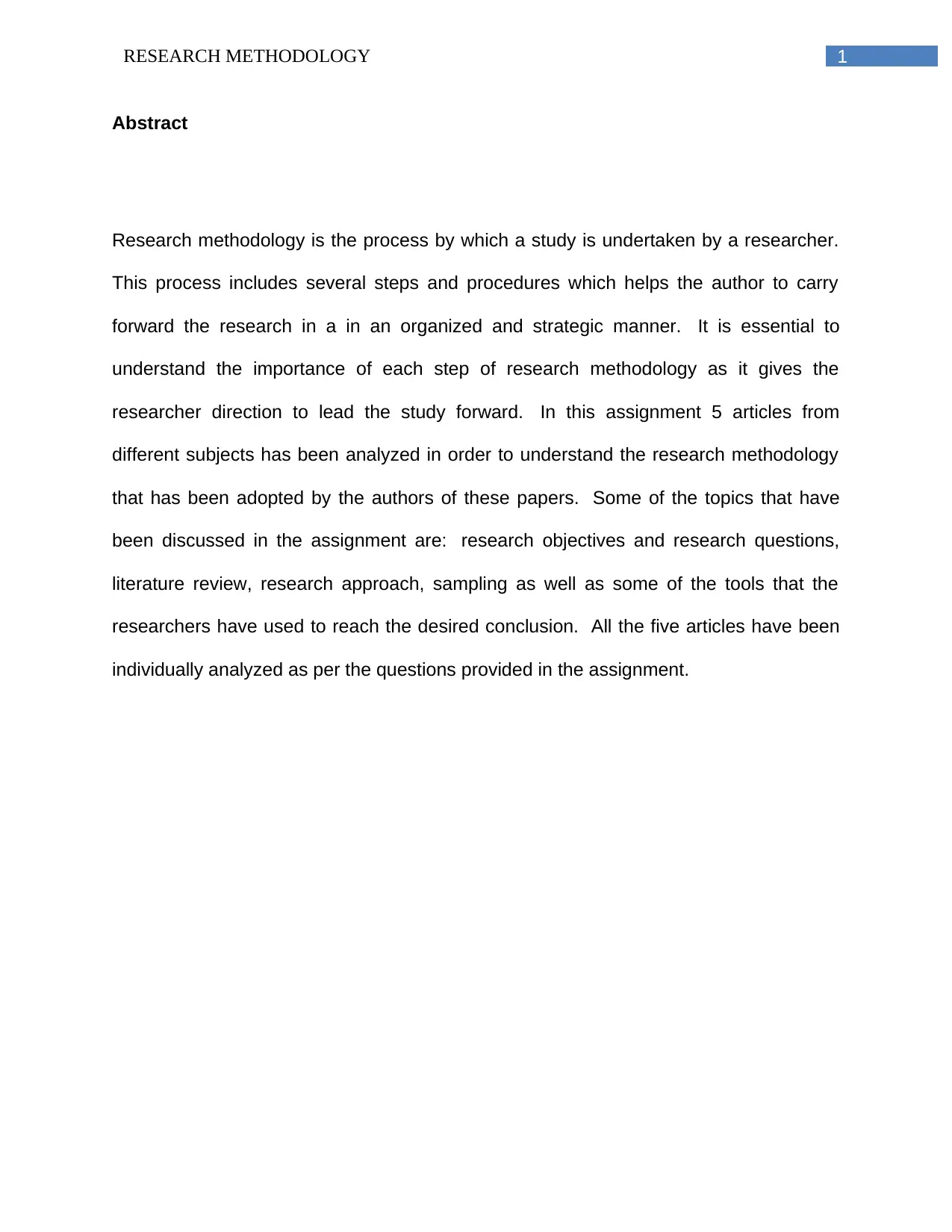
1RESEARCH METHODOLOGY
Abstract
Research methodology is the process by which a study is undertaken by a researcher.
This process includes several steps and procedures which helps the author to carry
forward the research in a in an organized and strategic manner. It is essential to
understand the importance of each step of research methodology as it gives the
researcher direction to lead the study forward. In this assignment 5 articles from
different subjects has been analyzed in order to understand the research methodology
that has been adopted by the authors of these papers. Some of the topics that have
been discussed in the assignment are: research objectives and research questions,
literature review, research approach, sampling as well as some of the tools that the
researchers have used to reach the desired conclusion. All the five articles have been
individually analyzed as per the questions provided in the assignment.
Abstract
Research methodology is the process by which a study is undertaken by a researcher.
This process includes several steps and procedures which helps the author to carry
forward the research in a in an organized and strategic manner. It is essential to
understand the importance of each step of research methodology as it gives the
researcher direction to lead the study forward. In this assignment 5 articles from
different subjects has been analyzed in order to understand the research methodology
that has been adopted by the authors of these papers. Some of the topics that have
been discussed in the assignment are: research objectives and research questions,
literature review, research approach, sampling as well as some of the tools that the
researchers have used to reach the desired conclusion. All the five articles have been
individually analyzed as per the questions provided in the assignment.
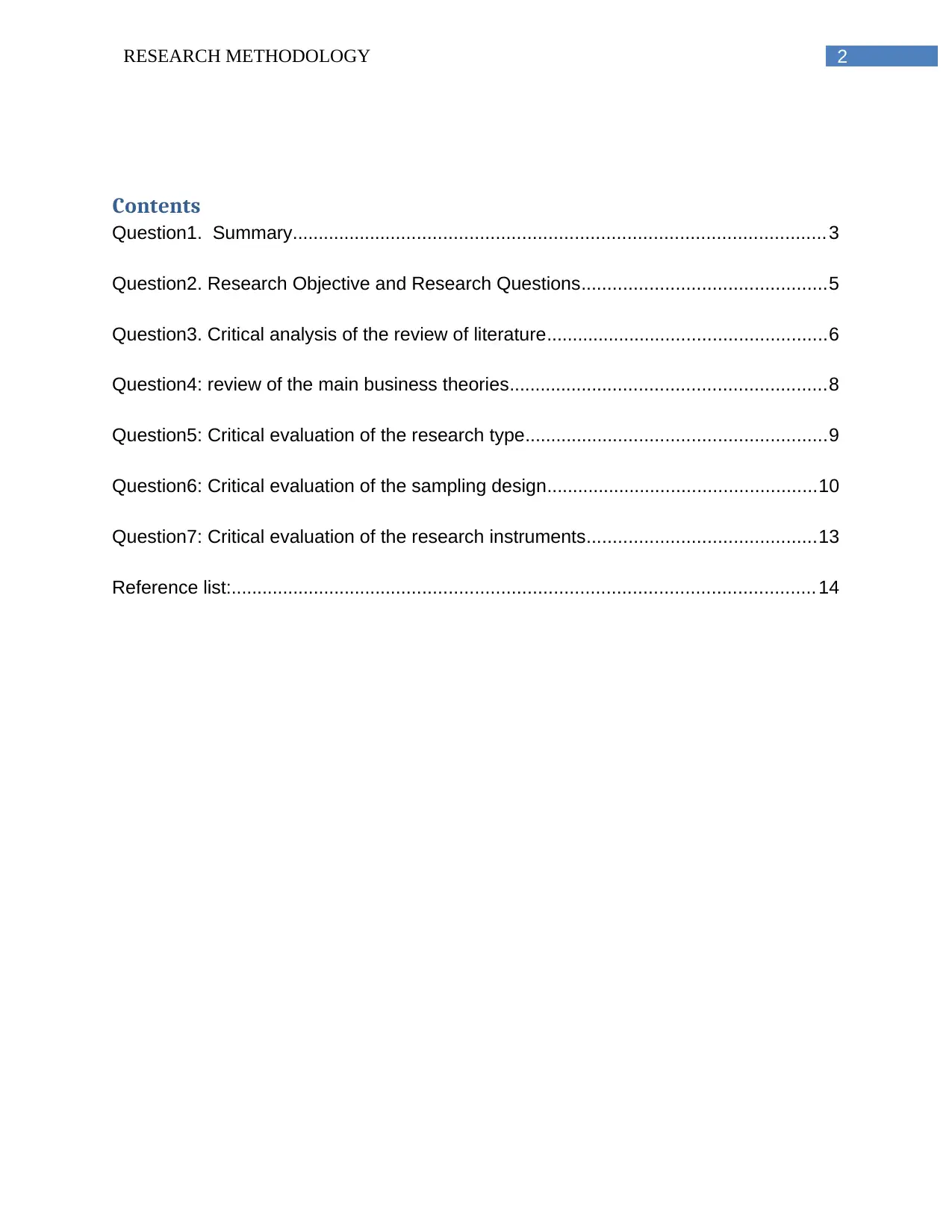
2RESEARCH METHODOLOGY
Contents
Question1. Summary...................................................................................................... 3
Question2. Research Objective and Research Questions...............................................5
Question3. Critical analysis of the review of literature......................................................6
Question4: review of the main business theories.............................................................8
Question5: Critical evaluation of the research type..........................................................9
Question6: Critical evaluation of the sampling design....................................................10
Question7: Critical evaluation of the research instruments............................................13
Reference list:................................................................................................................ 14
Contents
Question1. Summary...................................................................................................... 3
Question2. Research Objective and Research Questions...............................................5
Question3. Critical analysis of the review of literature......................................................6
Question4: review of the main business theories.............................................................8
Question5: Critical evaluation of the research type..........................................................9
Question6: Critical evaluation of the sampling design....................................................10
Question7: Critical evaluation of the research instruments............................................13
Reference list:................................................................................................................ 14
⊘ This is a preview!⊘
Do you want full access?
Subscribe today to unlock all pages.

Trusted by 1+ million students worldwide
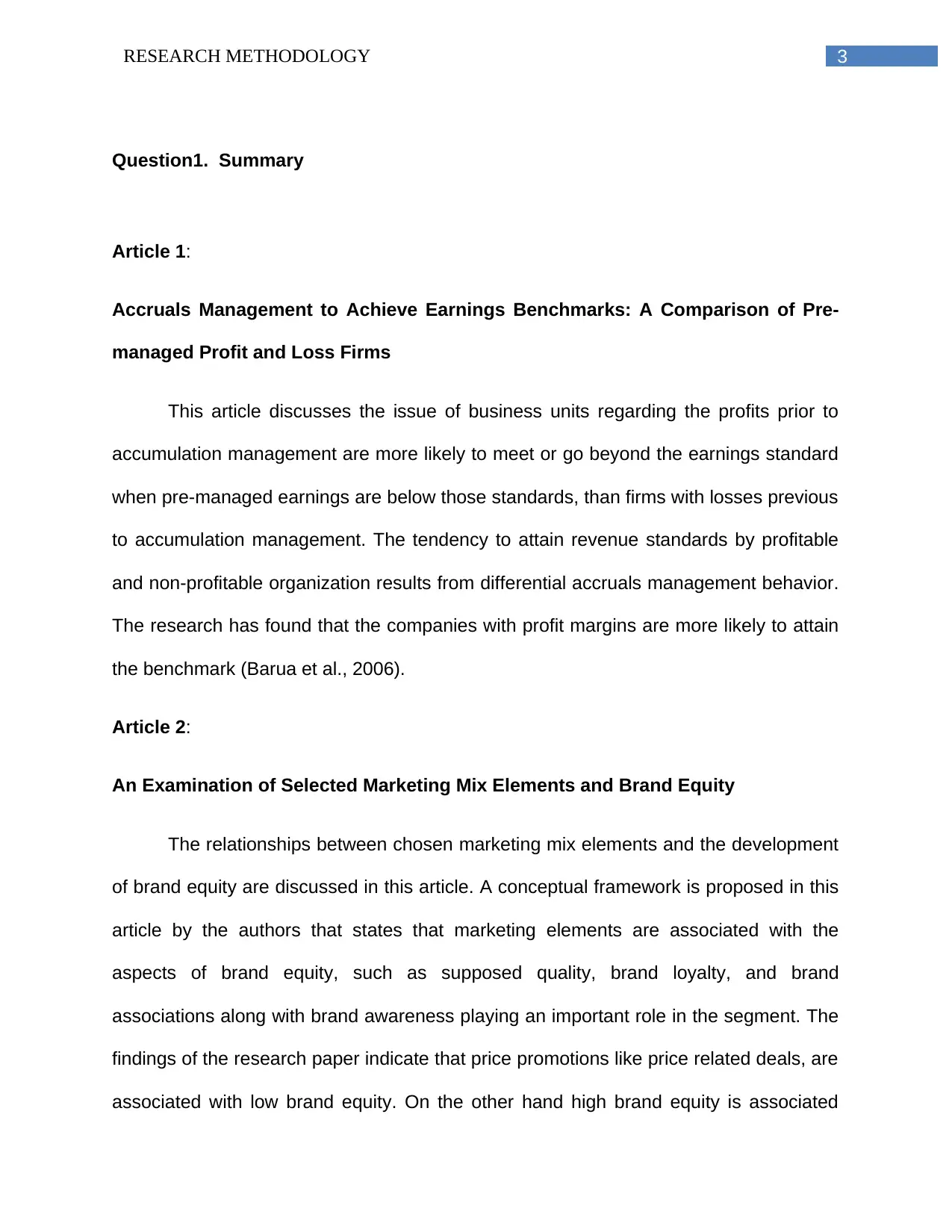
3RESEARCH METHODOLOGY
Question1. Summary
Article 1:
Accruals Management to Achieve Earnings Benchmarks: A Comparison of Pre-
managed Profit and Loss Firms
This article discusses the issue of business units regarding the profits prior to
accumulation management are more likely to meet or go beyond the earnings standard
when pre-managed earnings are below those standards, than firms with losses previous
to accumulation management. The tendency to attain revenue standards by profitable
and non-profitable organization results from differential accruals management behavior.
The research has found that the companies with profit margins are more likely to attain
the benchmark (Barua et al., 2006).
Article 2:
An Examination of Selected Marketing Mix Elements and Brand Equity
The relationships between chosen marketing mix elements and the development
of brand equity are discussed in this article. A conceptual framework is proposed in this
article by the authors that states that marketing elements are associated with the
aspects of brand equity, such as supposed quality, brand loyalty, and brand
associations along with brand awareness playing an important role in the segment. The
findings of the research paper indicate that price promotions like price related deals, are
associated with low brand equity. On the other hand high brand equity is associated
Question1. Summary
Article 1:
Accruals Management to Achieve Earnings Benchmarks: A Comparison of Pre-
managed Profit and Loss Firms
This article discusses the issue of business units regarding the profits prior to
accumulation management are more likely to meet or go beyond the earnings standard
when pre-managed earnings are below those standards, than firms with losses previous
to accumulation management. The tendency to attain revenue standards by profitable
and non-profitable organization results from differential accruals management behavior.
The research has found that the companies with profit margins are more likely to attain
the benchmark (Barua et al., 2006).
Article 2:
An Examination of Selected Marketing Mix Elements and Brand Equity
The relationships between chosen marketing mix elements and the development
of brand equity are discussed in this article. A conceptual framework is proposed in this
article by the authors that states that marketing elements are associated with the
aspects of brand equity, such as supposed quality, brand loyalty, and brand
associations along with brand awareness playing an important role in the segment. The
findings of the research paper indicate that price promotions like price related deals, are
associated with low brand equity. On the other hand high brand equity is associated
Paraphrase This Document
Need a fresh take? Get an instant paraphrase of this document with our AI Paraphraser
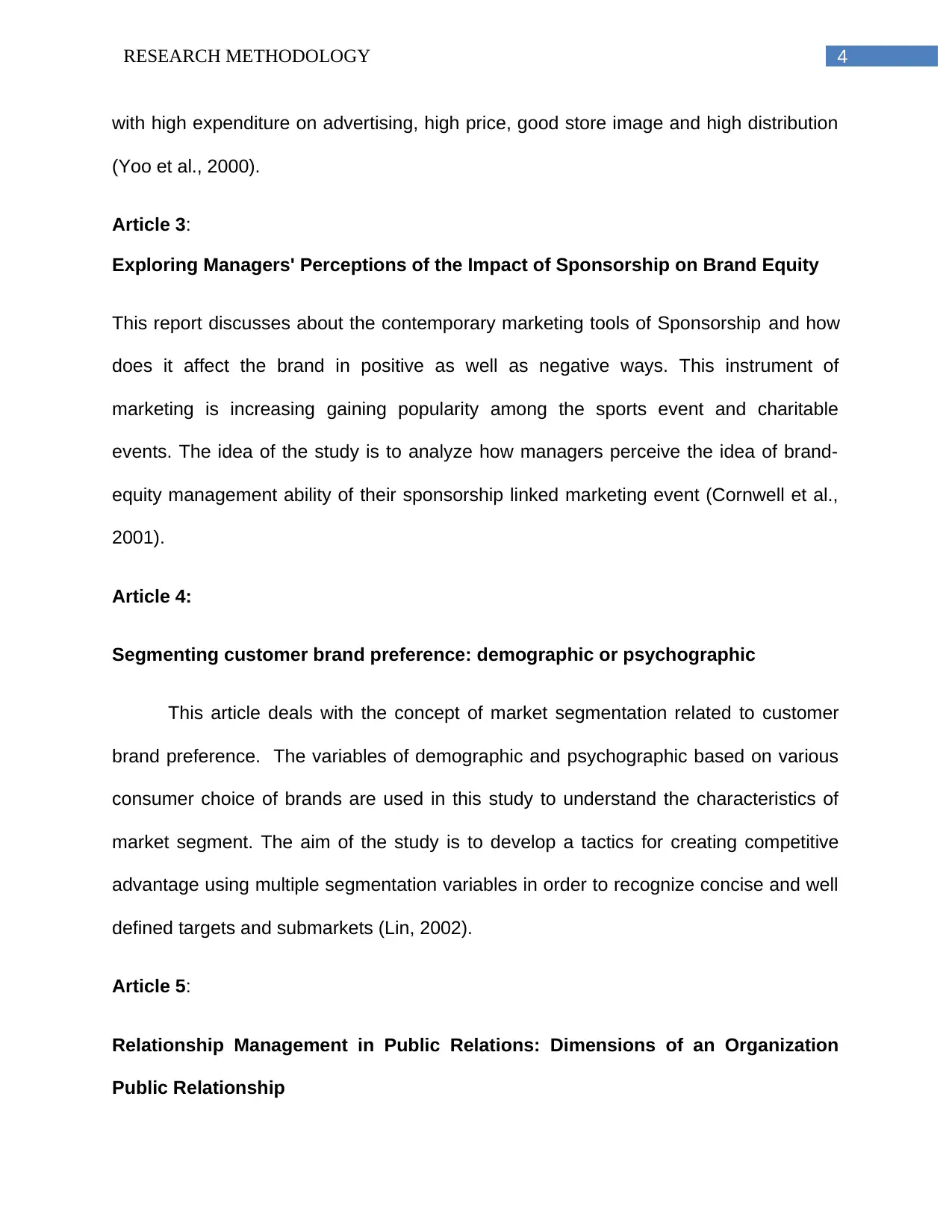
4RESEARCH METHODOLOGY
with high expenditure on advertising, high price, good store image and high distribution
(Yoo et al., 2000).
Article 3:
Exploring Managers' Perceptions of the Impact of Sponsorship on Brand Equity
This report discusses about the contemporary marketing tools of Sponsorship and how
does it affect the brand in positive as well as negative ways. This instrument of
marketing is increasing gaining popularity among the sports event and charitable
events. The idea of the study is to analyze how managers perceive the idea of brand-
equity management ability of their sponsorship linked marketing event (Cornwell et al.,
2001).
Article 4:
Segmenting customer brand preference: demographic or psychographic
This article deals with the concept of market segmentation related to customer
brand preference. The variables of demographic and psychographic based on various
consumer choice of brands are used in this study to understand the characteristics of
market segment. The aim of the study is to develop a tactics for creating competitive
advantage using multiple segmentation variables in order to recognize concise and well
defined targets and submarkets (Lin, 2002).
Article 5:
Relationship Management in Public Relations: Dimensions of an Organization
Public Relationship
with high expenditure on advertising, high price, good store image and high distribution
(Yoo et al., 2000).
Article 3:
Exploring Managers' Perceptions of the Impact of Sponsorship on Brand Equity
This report discusses about the contemporary marketing tools of Sponsorship and how
does it affect the brand in positive as well as negative ways. This instrument of
marketing is increasing gaining popularity among the sports event and charitable
events. The idea of the study is to analyze how managers perceive the idea of brand-
equity management ability of their sponsorship linked marketing event (Cornwell et al.,
2001).
Article 4:
Segmenting customer brand preference: demographic or psychographic
This article deals with the concept of market segmentation related to customer
brand preference. The variables of demographic and psychographic based on various
consumer choice of brands are used in this study to understand the characteristics of
market segment. The aim of the study is to develop a tactics for creating competitive
advantage using multiple segmentation variables in order to recognize concise and well
defined targets and submarkets (Lin, 2002).
Article 5:
Relationship Management in Public Relations: Dimensions of an Organization
Public Relationship
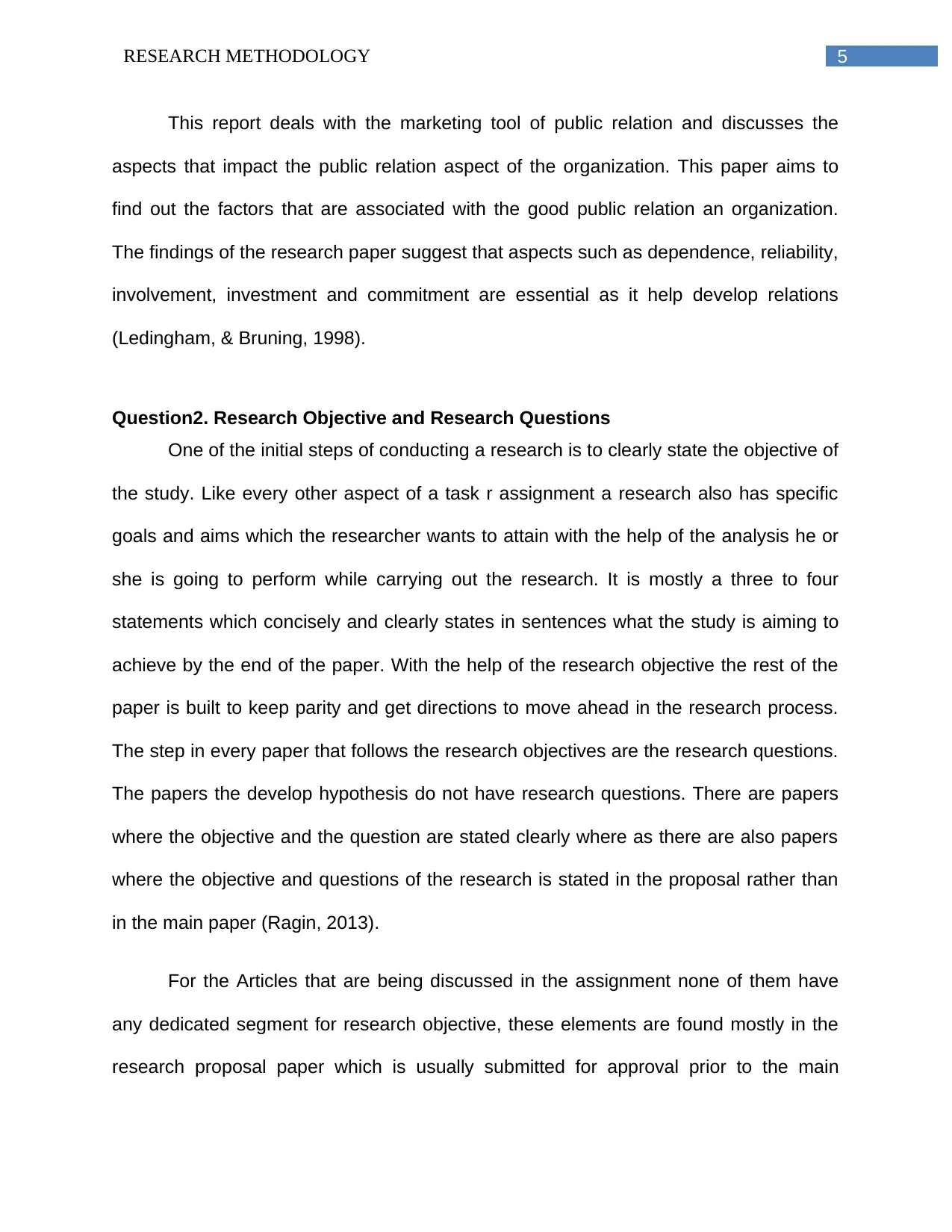
5RESEARCH METHODOLOGY
This report deals with the marketing tool of public relation and discusses the
aspects that impact the public relation aspect of the organization. This paper aims to
find out the factors that are associated with the good public relation an organization.
The findings of the research paper suggest that aspects such as dependence, reliability,
involvement, investment and commitment are essential as it help develop relations
(Ledingham, & Bruning, 1998).
Question2. Research Objective and Research Questions
One of the initial steps of conducting a research is to clearly state the objective of
the study. Like every other aspect of a task r assignment a research also has specific
goals and aims which the researcher wants to attain with the help of the analysis he or
she is going to perform while carrying out the research. It is mostly a three to four
statements which concisely and clearly states in sentences what the study is aiming to
achieve by the end of the paper. With the help of the research objective the rest of the
paper is built to keep parity and get directions to move ahead in the research process.
The step in every paper that follows the research objectives are the research questions.
The papers the develop hypothesis do not have research questions. There are papers
where the objective and the question are stated clearly where as there are also papers
where the objective and questions of the research is stated in the proposal rather than
in the main paper (Ragin, 2013).
For the Articles that are being discussed in the assignment none of them have
any dedicated segment for research objective, these elements are found mostly in the
research proposal paper which is usually submitted for approval prior to the main
This report deals with the marketing tool of public relation and discusses the
aspects that impact the public relation aspect of the organization. This paper aims to
find out the factors that are associated with the good public relation an organization.
The findings of the research paper suggest that aspects such as dependence, reliability,
involvement, investment and commitment are essential as it help develop relations
(Ledingham, & Bruning, 1998).
Question2. Research Objective and Research Questions
One of the initial steps of conducting a research is to clearly state the objective of
the study. Like every other aspect of a task r assignment a research also has specific
goals and aims which the researcher wants to attain with the help of the analysis he or
she is going to perform while carrying out the research. It is mostly a three to four
statements which concisely and clearly states in sentences what the study is aiming to
achieve by the end of the paper. With the help of the research objective the rest of the
paper is built to keep parity and get directions to move ahead in the research process.
The step in every paper that follows the research objectives are the research questions.
The papers the develop hypothesis do not have research questions. There are papers
where the objective and the question are stated clearly where as there are also papers
where the objective and questions of the research is stated in the proposal rather than
in the main paper (Ragin, 2013).
For the Articles that are being discussed in the assignment none of them have
any dedicated segment for research objective, these elements are found mostly in the
research proposal paper which is usually submitted for approval prior to the main
⊘ This is a preview!⊘
Do you want full access?
Subscribe today to unlock all pages.

Trusted by 1+ million students worldwide
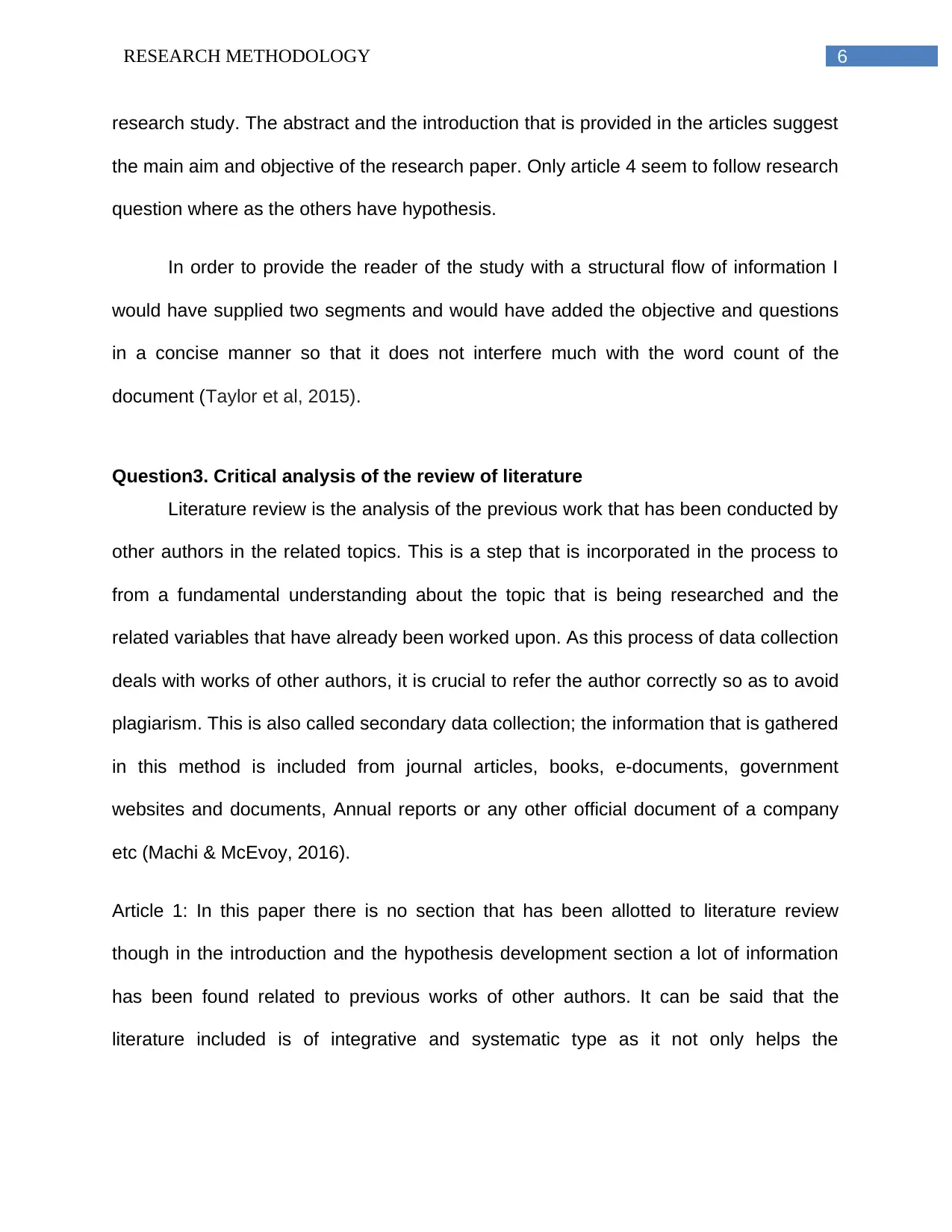
6RESEARCH METHODOLOGY
research study. The abstract and the introduction that is provided in the articles suggest
the main aim and objective of the research paper. Only article 4 seem to follow research
question where as the others have hypothesis.
In order to provide the reader of the study with a structural flow of information I
would have supplied two segments and would have added the objective and questions
in a concise manner so that it does not interfere much with the word count of the
document (Taylor et al, 2015).
Question3. Critical analysis of the review of literature
Literature review is the analysis of the previous work that has been conducted by
other authors in the related topics. This is a step that is incorporated in the process to
from a fundamental understanding about the topic that is being researched and the
related variables that have already been worked upon. As this process of data collection
deals with works of other authors, it is crucial to refer the author correctly so as to avoid
plagiarism. This is also called secondary data collection; the information that is gathered
in this method is included from journal articles, books, e-documents, government
websites and documents, Annual reports or any other official document of a company
etc (Machi & McEvoy, 2016).
Article 1: In this paper there is no section that has been allotted to literature review
though in the introduction and the hypothesis development section a lot of information
has been found related to previous works of other authors. It can be said that the
literature included is of integrative and systematic type as it not only helps the
research study. The abstract and the introduction that is provided in the articles suggest
the main aim and objective of the research paper. Only article 4 seem to follow research
question where as the others have hypothesis.
In order to provide the reader of the study with a structural flow of information I
would have supplied two segments and would have added the objective and questions
in a concise manner so that it does not interfere much with the word count of the
document (Taylor et al, 2015).
Question3. Critical analysis of the review of literature
Literature review is the analysis of the previous work that has been conducted by
other authors in the related topics. This is a step that is incorporated in the process to
from a fundamental understanding about the topic that is being researched and the
related variables that have already been worked upon. As this process of data collection
deals with works of other authors, it is crucial to refer the author correctly so as to avoid
plagiarism. This is also called secondary data collection; the information that is gathered
in this method is included from journal articles, books, e-documents, government
websites and documents, Annual reports or any other official document of a company
etc (Machi & McEvoy, 2016).
Article 1: In this paper there is no section that has been allotted to literature review
though in the introduction and the hypothesis development section a lot of information
has been found related to previous works of other authors. It can be said that the
literature included is of integrative and systematic type as it not only helps the
Paraphrase This Document
Need a fresh take? Get an instant paraphrase of this document with our AI Paraphraser
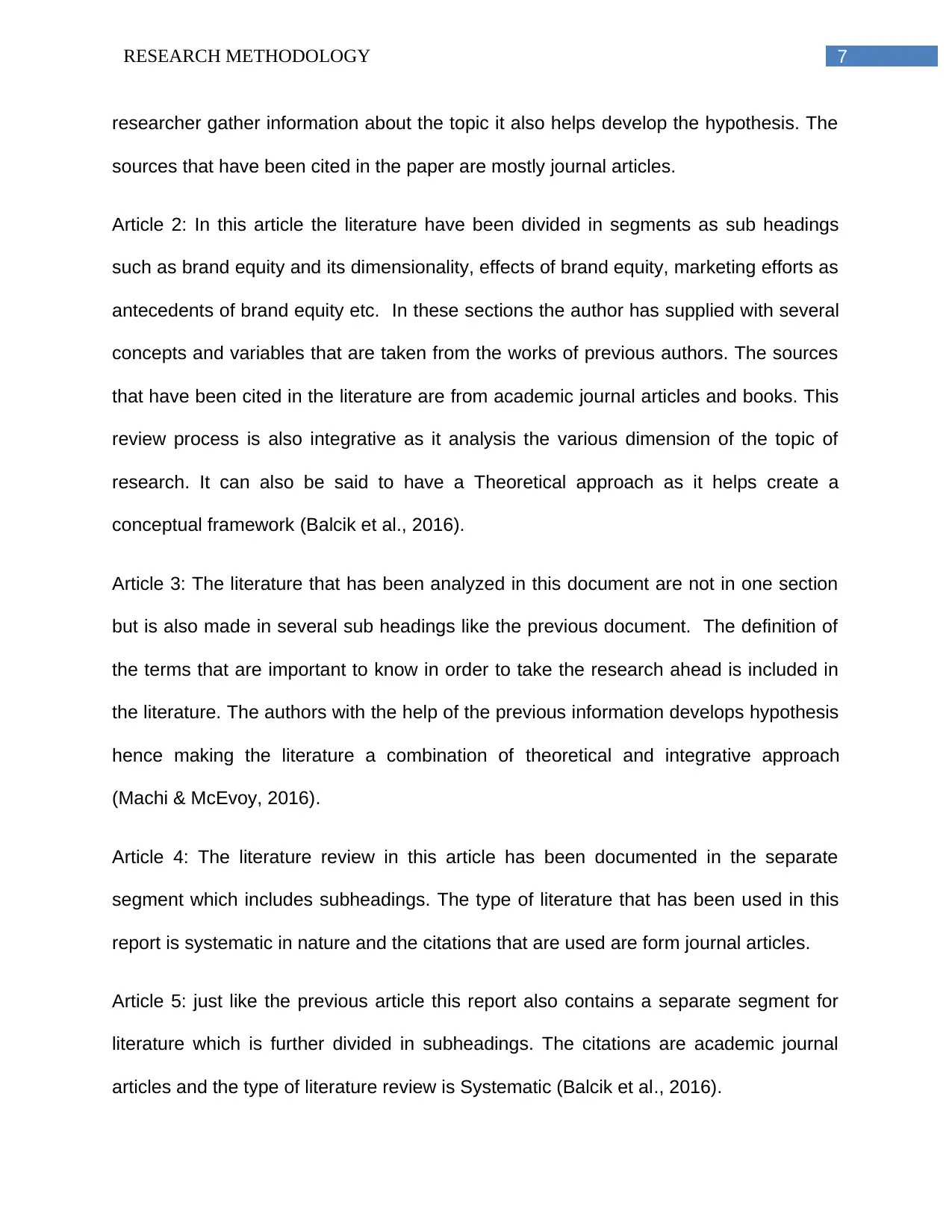
7RESEARCH METHODOLOGY
researcher gather information about the topic it also helps develop the hypothesis. The
sources that have been cited in the paper are mostly journal articles.
Article 2: In this article the literature have been divided in segments as sub headings
such as brand equity and its dimensionality, effects of brand equity, marketing efforts as
antecedents of brand equity etc. In these sections the author has supplied with several
concepts and variables that are taken from the works of previous authors. The sources
that have been cited in the literature are from academic journal articles and books. This
review process is also integrative as it analysis the various dimension of the topic of
research. It can also be said to have a Theoretical approach as it helps create a
conceptual framework (Balcik et al., 2016).
Article 3: The literature that has been analyzed in this document are not in one section
but is also made in several sub headings like the previous document. The definition of
the terms that are important to know in order to take the research ahead is included in
the literature. The authors with the help of the previous information develops hypothesis
hence making the literature a combination of theoretical and integrative approach
(Machi & McEvoy, 2016).
Article 4: The literature review in this article has been documented in the separate
segment which includes subheadings. The type of literature that has been used in this
report is systematic in nature and the citations that are used are form journal articles.
Article 5: just like the previous article this report also contains a separate segment for
literature which is further divided in subheadings. The citations are academic journal
articles and the type of literature review is Systematic (Balcik et al., 2016).
researcher gather information about the topic it also helps develop the hypothesis. The
sources that have been cited in the paper are mostly journal articles.
Article 2: In this article the literature have been divided in segments as sub headings
such as brand equity and its dimensionality, effects of brand equity, marketing efforts as
antecedents of brand equity etc. In these sections the author has supplied with several
concepts and variables that are taken from the works of previous authors. The sources
that have been cited in the literature are from academic journal articles and books. This
review process is also integrative as it analysis the various dimension of the topic of
research. It can also be said to have a Theoretical approach as it helps create a
conceptual framework (Balcik et al., 2016).
Article 3: The literature that has been analyzed in this document are not in one section
but is also made in several sub headings like the previous document. The definition of
the terms that are important to know in order to take the research ahead is included in
the literature. The authors with the help of the previous information develops hypothesis
hence making the literature a combination of theoretical and integrative approach
(Machi & McEvoy, 2016).
Article 4: The literature review in this article has been documented in the separate
segment which includes subheadings. The type of literature that has been used in this
report is systematic in nature and the citations that are used are form journal articles.
Article 5: just like the previous article this report also contains a separate segment for
literature which is further divided in subheadings. The citations are academic journal
articles and the type of literature review is Systematic (Balcik et al., 2016).
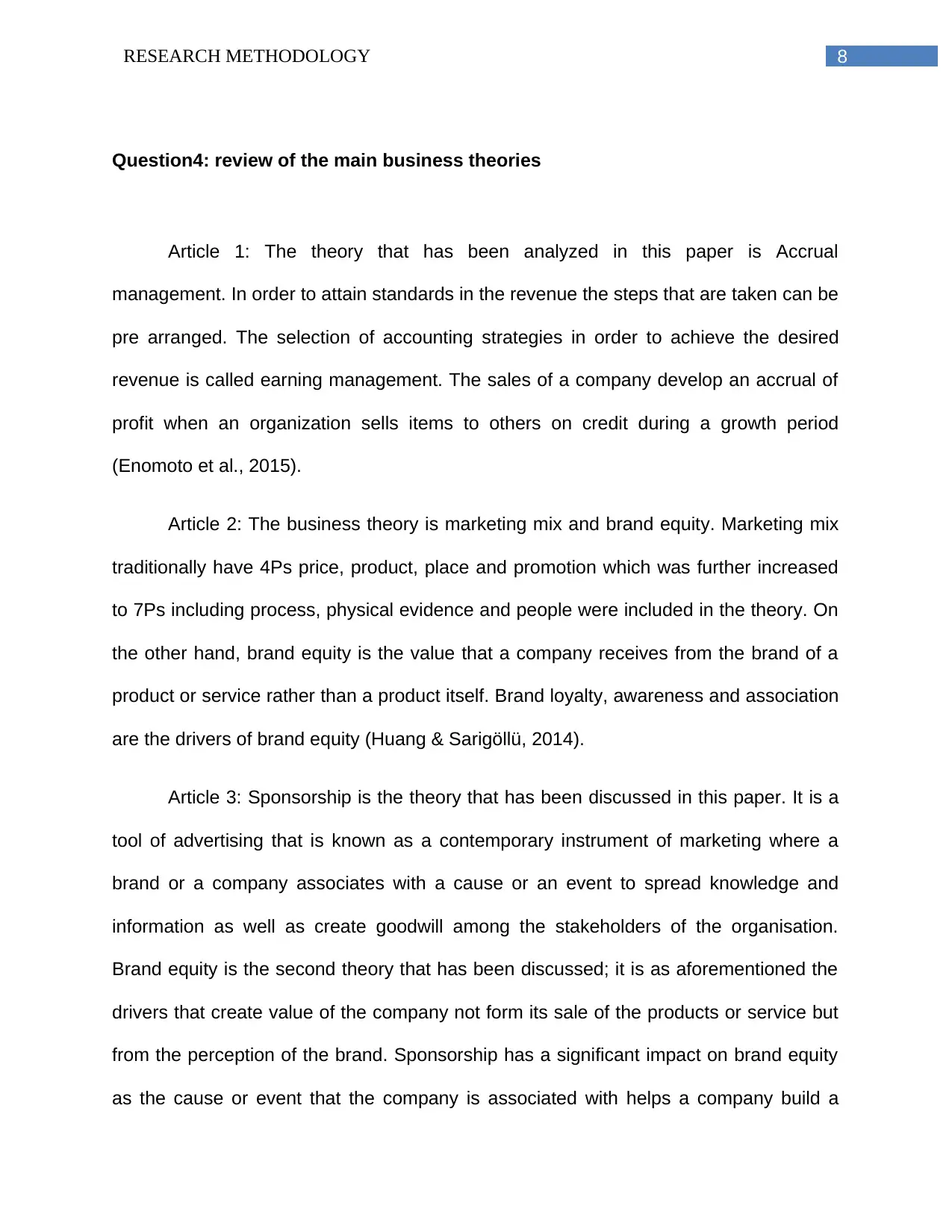
8RESEARCH METHODOLOGY
Question4: review of the main business theories
Article 1: The theory that has been analyzed in this paper is Accrual
management. In order to attain standards in the revenue the steps that are taken can be
pre arranged. The selection of accounting strategies in order to achieve the desired
revenue is called earning management. The sales of a company develop an accrual of
profit when an organization sells items to others on credit during a growth period
(Enomoto et al., 2015).
Article 2: The business theory is marketing mix and brand equity. Marketing mix
traditionally have 4Ps price, product, place and promotion which was further increased
to 7Ps including process, physical evidence and people were included in the theory. On
the other hand, brand equity is the value that a company receives from the brand of a
product or service rather than a product itself. Brand loyalty, awareness and association
are the drivers of brand equity (Huang & Sarigöllü, 2014).
Article 3: Sponsorship is the theory that has been discussed in this paper. It is a
tool of advertising that is known as a contemporary instrument of marketing where a
brand or a company associates with a cause or an event to spread knowledge and
information as well as create goodwill among the stakeholders of the organisation.
Brand equity is the second theory that has been discussed; it is as aforementioned the
drivers that create value of the company not form its sale of the products or service but
from the perception of the brand. Sponsorship has a significant impact on brand equity
as the cause or event that the company is associated with helps a company build a
Question4: review of the main business theories
Article 1: The theory that has been analyzed in this paper is Accrual
management. In order to attain standards in the revenue the steps that are taken can be
pre arranged. The selection of accounting strategies in order to achieve the desired
revenue is called earning management. The sales of a company develop an accrual of
profit when an organization sells items to others on credit during a growth period
(Enomoto et al., 2015).
Article 2: The business theory is marketing mix and brand equity. Marketing mix
traditionally have 4Ps price, product, place and promotion which was further increased
to 7Ps including process, physical evidence and people were included in the theory. On
the other hand, brand equity is the value that a company receives from the brand of a
product or service rather than a product itself. Brand loyalty, awareness and association
are the drivers of brand equity (Huang & Sarigöllü, 2014).
Article 3: Sponsorship is the theory that has been discussed in this paper. It is a
tool of advertising that is known as a contemporary instrument of marketing where a
brand or a company associates with a cause or an event to spread knowledge and
information as well as create goodwill among the stakeholders of the organisation.
Brand equity is the second theory that has been discussed; it is as aforementioned the
drivers that create value of the company not form its sale of the products or service but
from the perception of the brand. Sponsorship has a significant impact on brand equity
as the cause or event that the company is associated with helps a company build a
⊘ This is a preview!⊘
Do you want full access?
Subscribe today to unlock all pages.

Trusted by 1+ million students worldwide
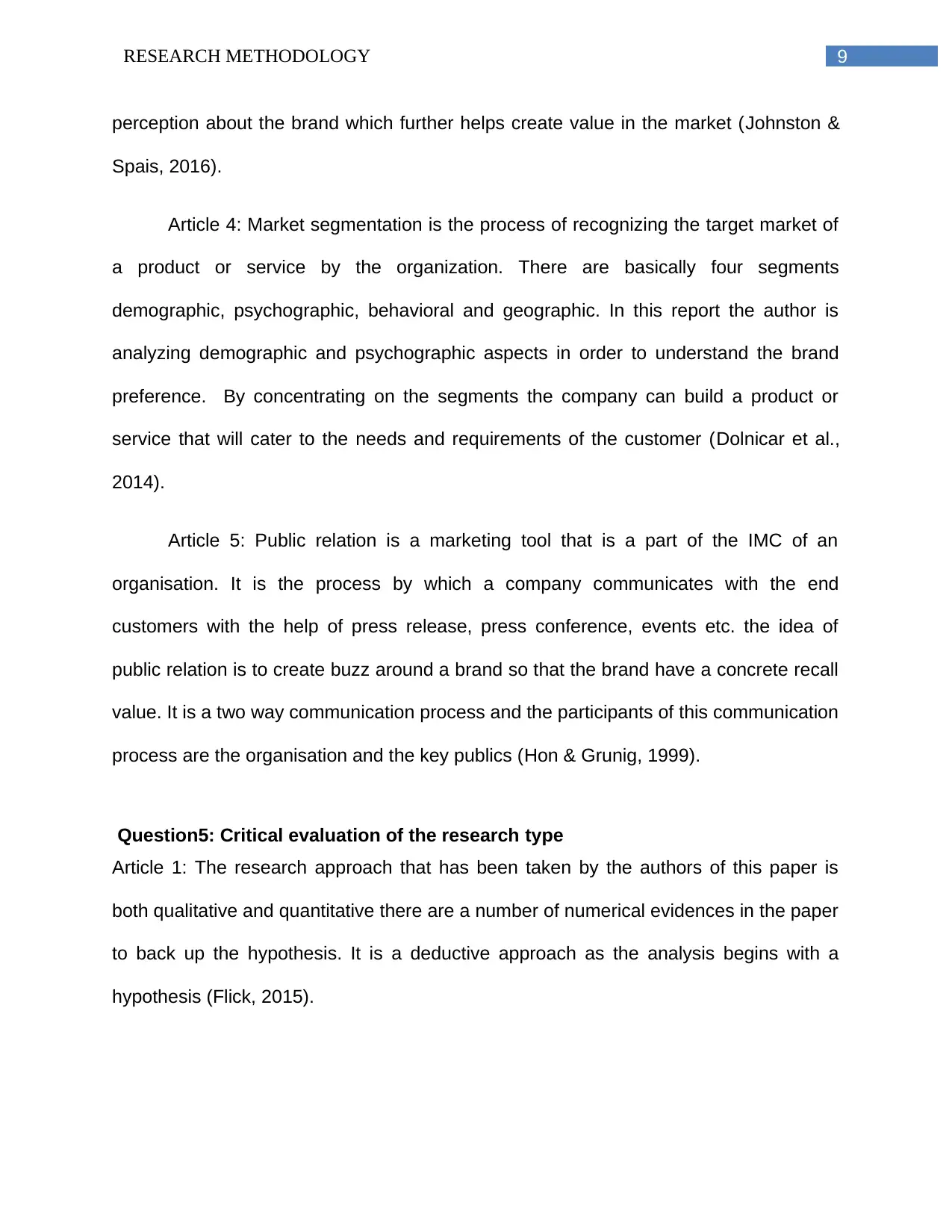
9RESEARCH METHODOLOGY
perception about the brand which further helps create value in the market (Johnston &
Spais, 2016).
Article 4: Market segmentation is the process of recognizing the target market of
a product or service by the organization. There are basically four segments
demographic, psychographic, behavioral and geographic. In this report the author is
analyzing demographic and psychographic aspects in order to understand the brand
preference. By concentrating on the segments the company can build a product or
service that will cater to the needs and requirements of the customer (Dolnicar et al.,
2014).
Article 5: Public relation is a marketing tool that is a part of the IMC of an
organisation. It is the process by which a company communicates with the end
customers with the help of press release, press conference, events etc. the idea of
public relation is to create buzz around a brand so that the brand have a concrete recall
value. It is a two way communication process and the participants of this communication
process are the organisation and the key publics (Hon & Grunig, 1999).
Question5: Critical evaluation of the research type
Article 1: The research approach that has been taken by the authors of this paper is
both qualitative and quantitative there are a number of numerical evidences in the paper
to back up the hypothesis. It is a deductive approach as the analysis begins with a
hypothesis (Flick, 2015).
perception about the brand which further helps create value in the market (Johnston &
Spais, 2016).
Article 4: Market segmentation is the process of recognizing the target market of
a product or service by the organization. There are basically four segments
demographic, psychographic, behavioral and geographic. In this report the author is
analyzing demographic and psychographic aspects in order to understand the brand
preference. By concentrating on the segments the company can build a product or
service that will cater to the needs and requirements of the customer (Dolnicar et al.,
2014).
Article 5: Public relation is a marketing tool that is a part of the IMC of an
organisation. It is the process by which a company communicates with the end
customers with the help of press release, press conference, events etc. the idea of
public relation is to create buzz around a brand so that the brand have a concrete recall
value. It is a two way communication process and the participants of this communication
process are the organisation and the key publics (Hon & Grunig, 1999).
Question5: Critical evaluation of the research type
Article 1: The research approach that has been taken by the authors of this paper is
both qualitative and quantitative there are a number of numerical evidences in the paper
to back up the hypothesis. It is a deductive approach as the analysis begins with a
hypothesis (Flick, 2015).
Paraphrase This Document
Need a fresh take? Get an instant paraphrase of this document with our AI Paraphraser
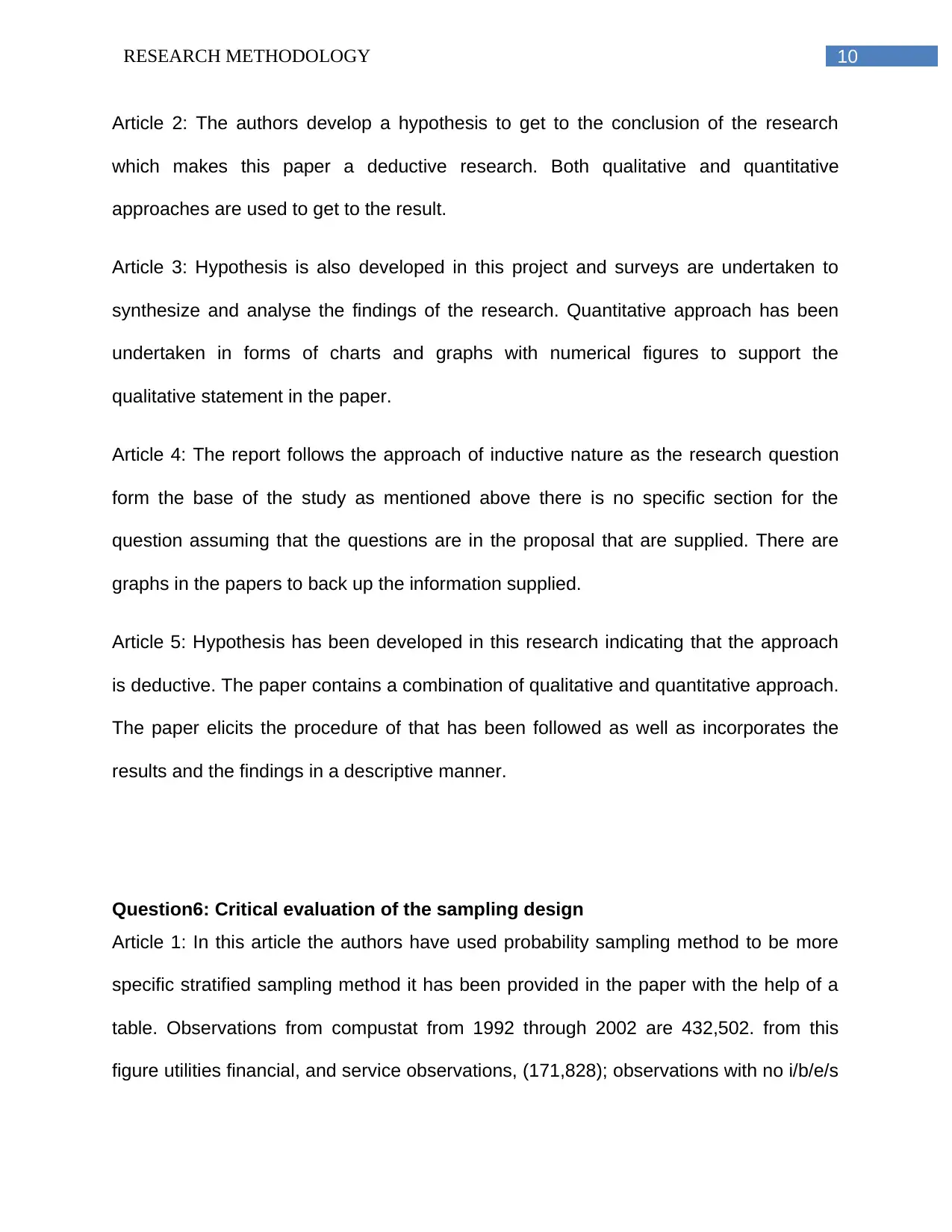
10RESEARCH METHODOLOGY
Article 2: The authors develop a hypothesis to get to the conclusion of the research
which makes this paper a deductive research. Both qualitative and quantitative
approaches are used to get to the result.
Article 3: Hypothesis is also developed in this project and surveys are undertaken to
synthesize and analyse the findings of the research. Quantitative approach has been
undertaken in forms of charts and graphs with numerical figures to support the
qualitative statement in the paper.
Article 4: The report follows the approach of inductive nature as the research question
form the base of the study as mentioned above there is no specific section for the
question assuming that the questions are in the proposal that are supplied. There are
graphs in the papers to back up the information supplied.
Article 5: Hypothesis has been developed in this research indicating that the approach
is deductive. The paper contains a combination of qualitative and quantitative approach.
The paper elicits the procedure of that has been followed as well as incorporates the
results and the findings in a descriptive manner.
Question6: Critical evaluation of the sampling design
Article 1: In this article the authors have used probability sampling method to be more
specific stratified sampling method it has been provided in the paper with the help of a
table. Observations from compustat from 1992 through 2002 are 432,502. from this
figure utilities financial, and service observations, (171,828); observations with no i/b/e/s
Article 2: The authors develop a hypothesis to get to the conclusion of the research
which makes this paper a deductive research. Both qualitative and quantitative
approaches are used to get to the result.
Article 3: Hypothesis is also developed in this project and surveys are undertaken to
synthesize and analyse the findings of the research. Quantitative approach has been
undertaken in forms of charts and graphs with numerical figures to support the
qualitative statement in the paper.
Article 4: The report follows the approach of inductive nature as the research question
form the base of the study as mentioned above there is no specific section for the
question assuming that the questions are in the proposal that are supplied. There are
graphs in the papers to back up the information supplied.
Article 5: Hypothesis has been developed in this research indicating that the approach
is deductive. The paper contains a combination of qualitative and quantitative approach.
The paper elicits the procedure of that has been followed as well as incorporates the
results and the findings in a descriptive manner.
Question6: Critical evaluation of the sampling design
Article 1: In this article the authors have used probability sampling method to be more
specific stratified sampling method it has been provided in the paper with the help of a
table. Observations from compustat from 1992 through 2002 are 432,502. from this
figure utilities financial, and service observations, (171,828); observations with no i/b/e/s
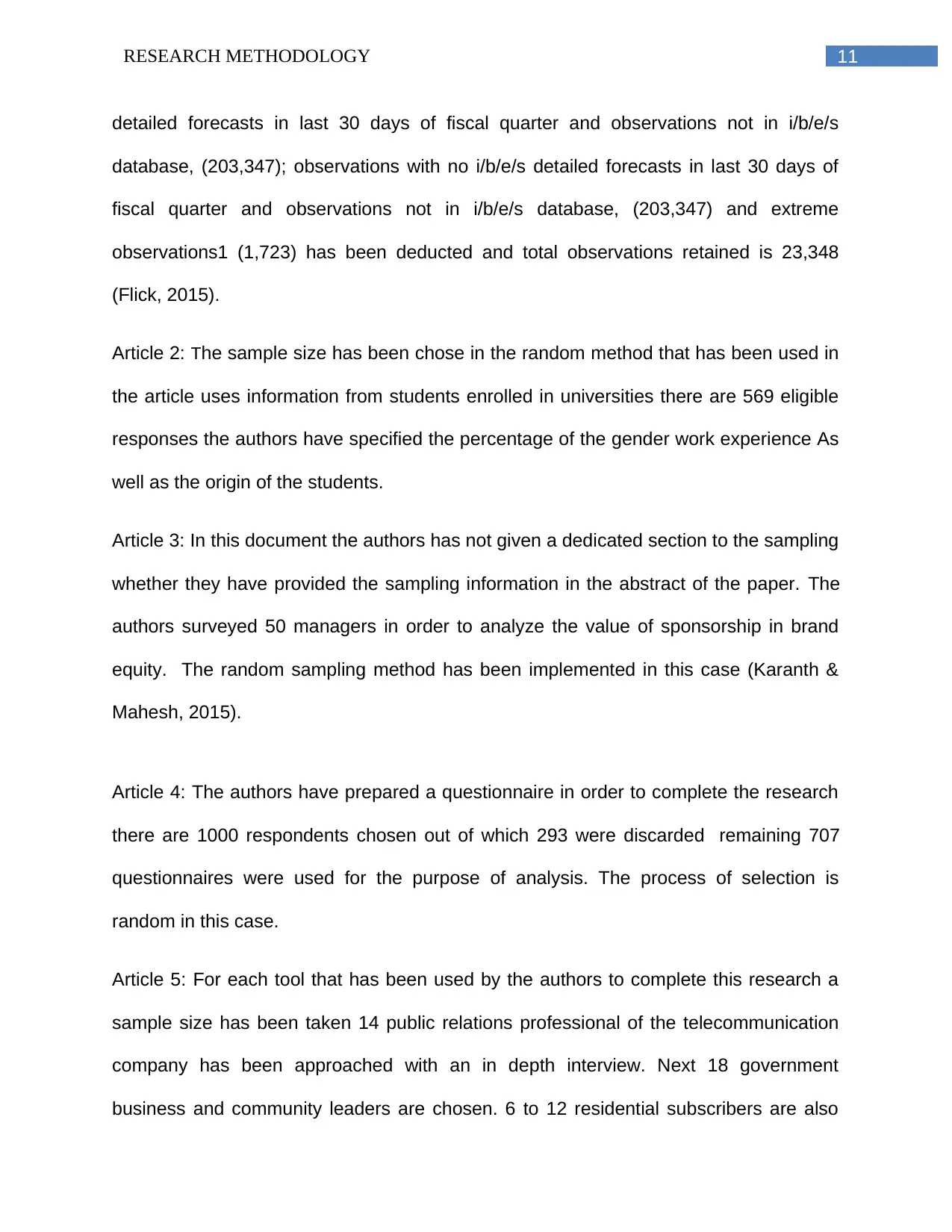
11RESEARCH METHODOLOGY
detailed forecasts in last 30 days of fiscal quarter and observations not in i/b/e/s
database, (203,347); observations with no i/b/e/s detailed forecasts in last 30 days of
fiscal quarter and observations not in i/b/e/s database, (203,347) and extreme
observations1 (1,723) has been deducted and total observations retained is 23,348
(Flick, 2015).
Article 2: The sample size has been chose in the random method that has been used in
the article uses information from students enrolled in universities there are 569 eligible
responses the authors have specified the percentage of the gender work experience As
well as the origin of the students.
Article 3: In this document the authors has not given a dedicated section to the sampling
whether they have provided the sampling information in the abstract of the paper. The
authors surveyed 50 managers in order to analyze the value of sponsorship in brand
equity. The random sampling method has been implemented in this case (Karanth &
Mahesh, 2015).
Article 4: The authors have prepared a questionnaire in order to complete the research
there are 1000 respondents chosen out of which 293 were discarded remaining 707
questionnaires were used for the purpose of analysis. The process of selection is
random in this case.
Article 5: For each tool that has been used by the authors to complete this research a
sample size has been taken 14 public relations professional of the telecommunication
company has been approached with an in depth interview. Next 18 government
business and community leaders are chosen. 6 to 12 residential subscribers are also
detailed forecasts in last 30 days of fiscal quarter and observations not in i/b/e/s
database, (203,347); observations with no i/b/e/s detailed forecasts in last 30 days of
fiscal quarter and observations not in i/b/e/s database, (203,347) and extreme
observations1 (1,723) has been deducted and total observations retained is 23,348
(Flick, 2015).
Article 2: The sample size has been chose in the random method that has been used in
the article uses information from students enrolled in universities there are 569 eligible
responses the authors have specified the percentage of the gender work experience As
well as the origin of the students.
Article 3: In this document the authors has not given a dedicated section to the sampling
whether they have provided the sampling information in the abstract of the paper. The
authors surveyed 50 managers in order to analyze the value of sponsorship in brand
equity. The random sampling method has been implemented in this case (Karanth &
Mahesh, 2015).
Article 4: The authors have prepared a questionnaire in order to complete the research
there are 1000 respondents chosen out of which 293 were discarded remaining 707
questionnaires were used for the purpose of analysis. The process of selection is
random in this case.
Article 5: For each tool that has been used by the authors to complete this research a
sample size has been taken 14 public relations professional of the telecommunication
company has been approached with an in depth interview. Next 18 government
business and community leaders are chosen. 6 to 12 residential subscribers are also
⊘ This is a preview!⊘
Do you want full access?
Subscribe today to unlock all pages.

Trusted by 1+ million students worldwide
1 out of 17
Your All-in-One AI-Powered Toolkit for Academic Success.
+13062052269
info@desklib.com
Available 24*7 on WhatsApp / Email
![[object Object]](/_next/static/media/star-bottom.7253800d.svg)
Unlock your academic potential
Copyright © 2020–2025 A2Z Services. All Rights Reserved. Developed and managed by ZUCOL.


